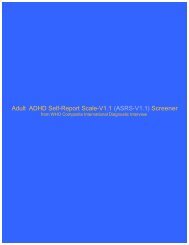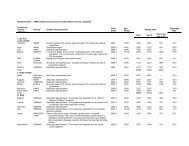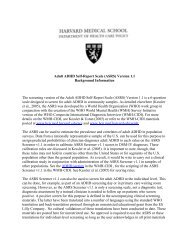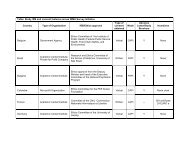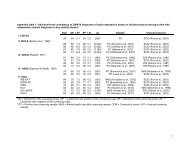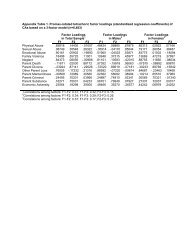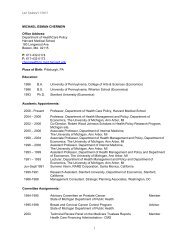Model Quality Report in Business Statistics - Harvard ...
Model Quality Report in Business Statistics - Harvard ...
Model Quality Report in Business Statistics - Harvard ...
Create successful ePaper yourself
Turn your PDF publications into a flip-book with our unique Google optimized e-Paper software.
In the case of poststratification the auxiliary vector is def<strong>in</strong>ed by x = ( γ γ γ ) T<br />
k<br />
1 k<br />
,...,<br />
pk<br />
,...,<br />
Pk<br />
⎧1 if unit k ∈U<br />
p<br />
2<br />
where, for p = 1,..., P,<br />
γ<br />
pk<br />
= ⎨<br />
and σ k<br />
= 1 for all k. This poststratification<br />
⎩0<br />
otherwise<br />
approach gives us one simple method of deal<strong>in</strong>g with outly<strong>in</strong>g observations <strong>in</strong> a survey, s<strong>in</strong>ce<br />
they can be moved <strong>in</strong>to an appropriate poststratum for estimation.<br />
Most of the classical estimators can be derived as special cases from the GREG estimator.<br />
For example, if x<br />
k<br />
= xk<br />
for all k and σ 2 k<br />
∝ x k<br />
, where x k<br />
is a cont<strong>in</strong>uous variable, and when<br />
nonresponse model (i) is used, then the follow<strong>in</strong>g estimator is obta<strong>in</strong>ed:<br />
$t<br />
yr<br />
=<br />
H<br />
∑ N y<br />
h=<br />
1<br />
H<br />
h<br />
∑ N x<br />
h=<br />
1<br />
h<br />
rh<br />
rh<br />
∑<br />
U<br />
x<br />
k<br />
(2.13)<br />
Estimator (2.13) is sometimes called the comb<strong>in</strong>ed ratio estimator.<br />
Sometimes the group totals ∑U<br />
p<br />
x<br />
k<br />
are known and, <strong>in</strong> this general case, the p-groups are<br />
called model groups. Let us present a simple example. As before assume that x k<br />
is a<br />
cont<strong>in</strong>uous variable, but here we know the quantities ∑ ; p = 1,..., P. Let<br />
( γ x γ x γ x ) T<br />
x<br />
k<br />
=<br />
1 k k<br />
,...,<br />
pk k<br />
,...,<br />
Pk k<br />
, σ 2 k<br />
∝ x k<br />
for each p-group, and the RHGs co<strong>in</strong>cide with<br />
strata (nonresponse model (i)) then the GREG estimator takes the form<br />
U p<br />
x k<br />
t$<br />
yr<br />
=<br />
H<br />
$<br />
P<br />
∑ N<br />
h=<br />
1<br />
∑<br />
H<br />
p=<br />
1<br />
∑ N$<br />
h=<br />
1<br />
hp<br />
hp<br />
y<br />
x<br />
rhp<br />
rhp<br />
∑<br />
U p<br />
x<br />
k<br />
(2.14)<br />
If strata and model groups co<strong>in</strong>cide then estimator (2.14) can be written<br />
$t<br />
yr<br />
H yr<br />
h<br />
= ∑ ∑<br />
h=1<br />
x<br />
r<br />
h<br />
U<br />
h<br />
x<br />
k<br />
(2.15)<br />
Estimator (2.15) is sometimes called the separate ratio estimator.<br />
When x<br />
k<br />
= ( 1, xk<br />
) for all k and σ<br />
2 k<br />
= constant , then the classical regression estimator is<br />
obta<strong>in</strong>ed.<br />
Many bus<strong>in</strong>ess surveys are subject to occasional unusual observations, or outliers, which can<br />
have a large effect on the estimates. In these cases, robust versions of po<strong>in</strong>t estimators are<br />
often used, with the simplest be<strong>in</strong>g the poststratification estimator with the outliers <strong>in</strong> their<br />
own (completely enumerated) poststratum. This follows from the method above (2.13). Other<br />
methods <strong>in</strong>volve adjust<strong>in</strong>g the weights or the respond<strong>in</strong>g values, and w<strong>in</strong>sorisation is<br />
becom<strong>in</strong>g widely used with<strong>in</strong> the UK for treat<strong>in</strong>g outliers. This leads to a different estimator,<br />
which does not necessarily fit completely <strong>in</strong>to the GREG framework.<br />
8



